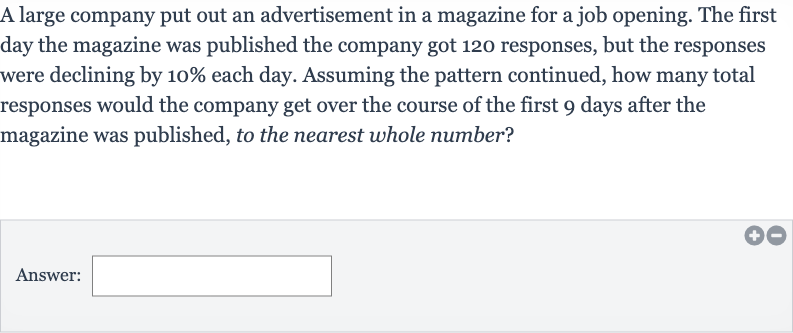AI tutor
Welcome to Bytelearn!
Let’s check out your problem:

A large company put out an advertisement in a magazine for a job opening. The first day the magazine was published the company got responses, but the responses were declining by each day. Assuming the pattern continued, how many total responses would the company get over the course of the first days after the magazine was published, to the nearest whole number?Answer:
Full solution
Q. A large company put out an advertisement in a magazine for a job opening. The first day the magazine was published the company got responses, but the responses were declining by each day. Assuming the pattern continued, how many total responses would the company get over the course of the first days after the magazine was published, to the nearest whole number?Answer:
- Identify initial responses and decrease: Identify the initial number of responses and the daily percentage decrease.Initial responses on the first day: Daily decrease:
- Calculate responses for each day: Calculate the number of responses for each day using the formula for the nth term of a geometric sequence, which is given by , where is the first term, is the common ratio, and is the term number.The common ratio is - . = . because the responses decrease by % each day.
- Calculate total responses over days: Calculate the total number of responses over the days by summing the geometric sequence.Total responses =
- Use formula for sum of geometric sequence: Use the formula for the sum of the first n terms of a geometric sequence, which is given by , where is the sum of the first n terms.For the first days, , so we calculate .
- Perform calculation for S_9: Perform the calculation for .
- Round total responses: Round the total number of responses to the nearest whole number.Rounded total responses = (to the nearest whole number)
More problems from Find probabilities using the binomial distribution
QuestionGet tutor help
QuestionGet tutor help
QuestionGet tutor help
QuestionGet tutor help
QuestionGet tutor help
QuestionGet tutor help
QuestionGet tutor help
QuestionGet tutor help
QuestionGet tutor help
QuestionGet tutor help
